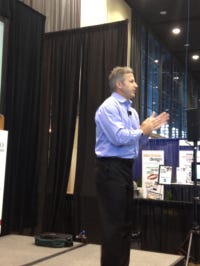How to save thousands on your next hire
Chicago—Have you ever asked a finalist for a position at your company for their most recent W-2? Russ Riendeau notes that this unconventional interview query could save your company thousands of dollars simply by ensuring that you don't over offer to a potential job candidate.
September 11, 2013
Chicago—Have you ever asked a finalist for a position at your company for their most recent W-2? Russ Riendeau notes that this unconventional interview query could save your company thousands of dollars simply by ensuring that you don't over offer to a potential job candidate. Riendeau, a senior partner at the East Wing Group and an executive head hunter with two decades of experience, said questions like that can help remove excess emotion from the hiring process and put measurable, science-based metrics in their place.
"Hiring is very emotional," Riendeau said. "We hire because we like them, we want to give them a chance. Often, we engage in emotions too much, and not enough science. We fail to measure the process of hiring, training."
Russ Riendeau |
Russ Riendeau offered PLASTEC Midwest attendees advice on how to |
Riendeau spoke at the Tech Theater presentation forum presented as part of UBM Canon's collocated advanced technologies shows at Chicago's McCormick Place, including PLASTEC Midwest, Design & Manufacturing Midwest, ATX Midwest, Pack Zone, Quality Expo, and MD&M Chicago.
The cost of a wrong hire
Riendeau asked the audience for their best estimate of what hiring the wrong person can cost a company. Responses ranged up to six figures; Riendeau noted that one company he worked with put the price tag of a bad hire at $1 million.
Part of the reason wrong hires are made comes back to the inability of some companies to look outside their own industry for new talent, choosing instead to seeking new staff at competitors or from within their own market space.
"In this room there are people walking by you who are qualified for your industry," Riendeau said, calling on companies to hire based on a prospect's "frontal cortex" versus whether or not they're in your "rolodex."
"People can learn a product," Riendeau said. "If you've increased sales in one industry, you can do it in another. Unlike mutual funds, where past performance isn't indicative of future results, that's not true in hiring."
Have a job spec, keep it current
Riendeau said that if companies have a job opening they need to keep a current, relevant job spec. They also need key initiatives, that is, three or four specific projects the new hire will need to accomplish within the next 12 months. These will be projects they will be measured on.
Better interviews
Once you have a job spec and applicants start coming in, you need to address your interviewing technique, Riendeau said. "Most people learn interviewing techniques by watching someone else," Riendeau, "but that person wasn't trained either."
Riendeau said interviews should ask behavioral-based questions, and offered three examples:
What questions do you have for me?
What would you like me to ask you first?
What do you know about our company?
The point, Riendeau said, is you want to get the candidate talking as quickly as possible to get to what their motivation is. In many cases, an interviewer will start with a history of their company, putting the candidate in more of a listening mode versus a talking mode.
30-, 60-, 90-day plan
For positions paying $60,000 and above, the final candidates should be asked to write a 30-, 60-, 90-day plan, with 24 hours to complete. Through this process, you might find out that the person who was your No. 1 candidate can't read or write, but your No. 2 is a "rock star," Riendeau said, who can articulate their thoughts nicely.
"You want to see how people think on paper," Riendeau explained. "There are lot of people who are great orators, great interviews, but they can't put their thoughts on paper."
First in a series
The presentation by Riendeau was sponsored by Dyna-Purge, and is the first in a series of four presentations, with the next three being online webinars. Dyna-Purge partnered with UL IDES on Riendeau's talk and will offer the recording on their site, starting Friday, September 13.
Tim Cutler, VP of the Dyna-Purge division of Shuman Plastics, told PlasticsToday that the concept for the webinar series came after his company conducted a survey of its readers. The top two issues: finding/retaining talent and training those hires once brought on board.
About the Author(s)
You May Also Like



